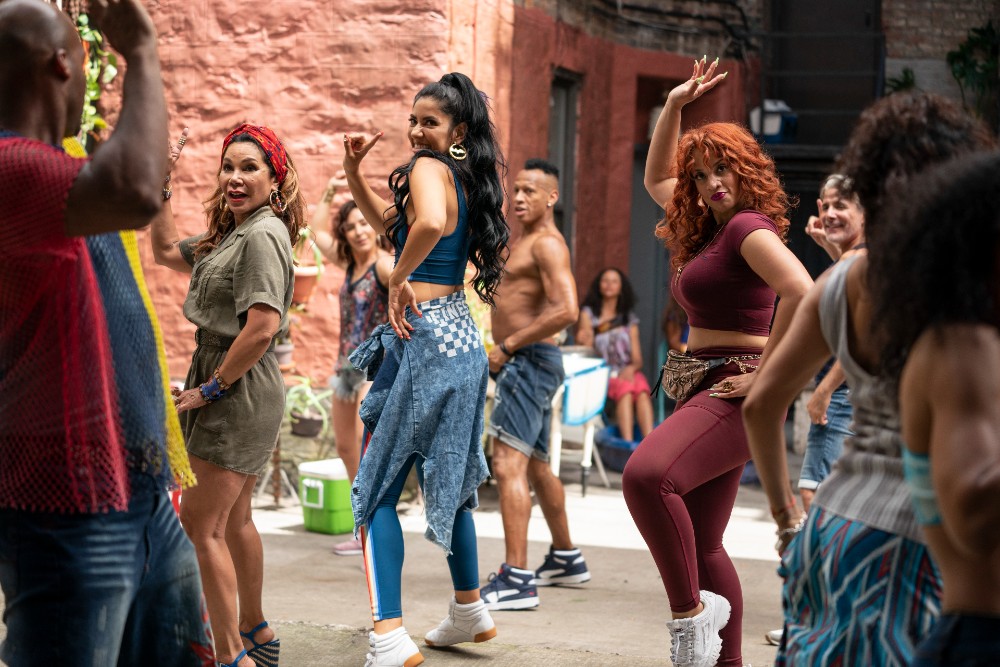
Every once in a while it happens where a great interview you’ve done just gets away from you. Some may remember that back in July, we ran a piece with Production Designer Nelson Coates, talking us through a specific scene and musical number in Jon M. Chu’s In the Heights, and how that was done. At the time, we promised to share the rest of that interview… and then, we didn’t. It was just one of those things that got shifted back over and over, as other things came up. And yet, it was a terrific and fairly long interview that deserved sharing.
Now, if you’re a member of the Art Directors Guild (ADG), of which ironically enough, Coates is currently the President, you’re probably aware that nominations are open right now for this year’s ADG Awards in film and television. If you’re a member of the Academy, you still have a good month before those nominations open.
But right now is a great time to catch up on films you may have missed earlier in the year, and in a year chock full of musicals, In the Heights is up there with some of the best, being based on Lin-Manuel Miranda’s precursor to Hamilton. (You can read J. Don Birnam’s review here.) In his role as Production Designer, Coates got to tackle a dream project that required him to redress a portion of Washington Heights to mirror how it looked in 2003, as it was facing gentrification, but the movie also required a rather complex procedure to be able to film a musical number in one of the Heights’ public swimming pools.
Incidentally, Coates was also Production Designer for the second season of The Morning Show on Apple TV, which involved recreating Times Square on an L.A. soundstage, which is an achievement in itself. He’s currently working on the long-awaited sequel, Hocus Pocus 2.
So again, this interview with Mr. Coates is from earlier in the year, but with In the Heights back on HBO Max and more people discovering it going into awards season, we hope you’ll give it a watch for his brilliant production design work in terms of recreating the actual Heights as seen in the film. Mr. Coates gave us a highly-detailed description of what went into finding the main location and recreating it on stages, but also talked about many specific scenes and locations. In other words, this interview is literally a textbook masterclass for anyone interested in getting into production design.
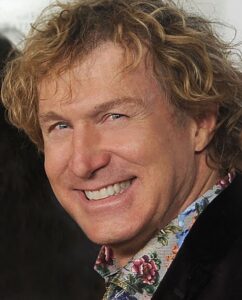
Below the Line: Before In the Heights, I know you’ve been in the art department for TV and movies for well over 30 years, and I’m curious about your background and how you got started down that road. Did you go to school for art and/or design?
Nelson Coates: Actually, I started acting professionally when I was six, and I’ve been singing, dancing and acting most of my whole life. The idea of actually designing a movie musical is so exactly in my wheelhouse, and yet, just because the same people have been doing them for so long. there are not a lot of opportunities in Hollywood. This is actually my first movie musical to design and actually is one of my favorite musicals of all time. So it is a crazy dream come true.
I was pre-med in college. I know, it doesn’t make any sense, but with university professors as parents, they didn’t know anybody who’d really made their living doing anything related to this, and it seemed like such a crapshoot. We had a lot of doctors and educators in the family, and they wanted to make sure that I wasn’t going to be living off them the rest of my life. it was a surprise, when, after performing and being in shows forever, and then I was doing a show that the set was not really executed well, and there was no drape. You realize that people are coming in thinking that’s gonna be the quality of the show. I told the producers that, “Well, I could do better than this,” and they said, “Well, no one’s doing our next show. It’s yours if you want.” So I started designing for the stage. And then, some folks saw some of my stage designs at the Dallas Theater Center, and asked me to design a pilot for a TV series.
They really had no money, and so it was a case of, I said, “Well, if it gets picked up, I get dibs to decide if I want to go with it or not.” It did and it ran for two years on PBS with a muppet-like character designed by the guy who designed Big Bird and Snuggles and Snufalopogaus, and then from there, I got my first movie, and you’re kind of going, “Oh, wait, when they cut the cake in the scene, I have to actually have another cake for Take 2. Okay!” I was blessed with a trajectory that not only was very fast, but was very incremental to learn what I didn’t know. Like that first movie, The Week, I was the location manager, location scout, propmaster, production designer, stunt coordinator, and greensman. Because, that’s what you did, and so you quickly learned skills, learned what you needed to be learning, and it kind of went from there. That history and that background of building things with my Dad and then going all the way through the theater where you’re literally building, dressing, painting the set yourself, has served me well, because you realize that you don’t have to be the best in each of the crafts. But I can pour the concrete and tie the steel and sew the drapes. If you have a language of each of those things, then you’re able to discuss with people who do that particular skill all day long every day to get where you want to go.
BTL: That makes sense. I was looking through your filmography, and I saw that you designed the first The Stand mini-series. I’ve been doing a lot of interviews with the people who did the current one, and they loved the original one and were trying not to copy too much of it.
Coates: I’m very proud of what we pulled off with that. It was like 220 sets and locations in 120, shooting days, with five states standing in for 25 different states. It was quite the challenge, and once I kind of passed that hurdle early in my career, I realized that pretty much the only thing standing in my way with me. You kind of go, “I give myself permission to strive even harder and do better work with each project and not be paralyzed or daunted by any challenge that’s thrown in front of you.”
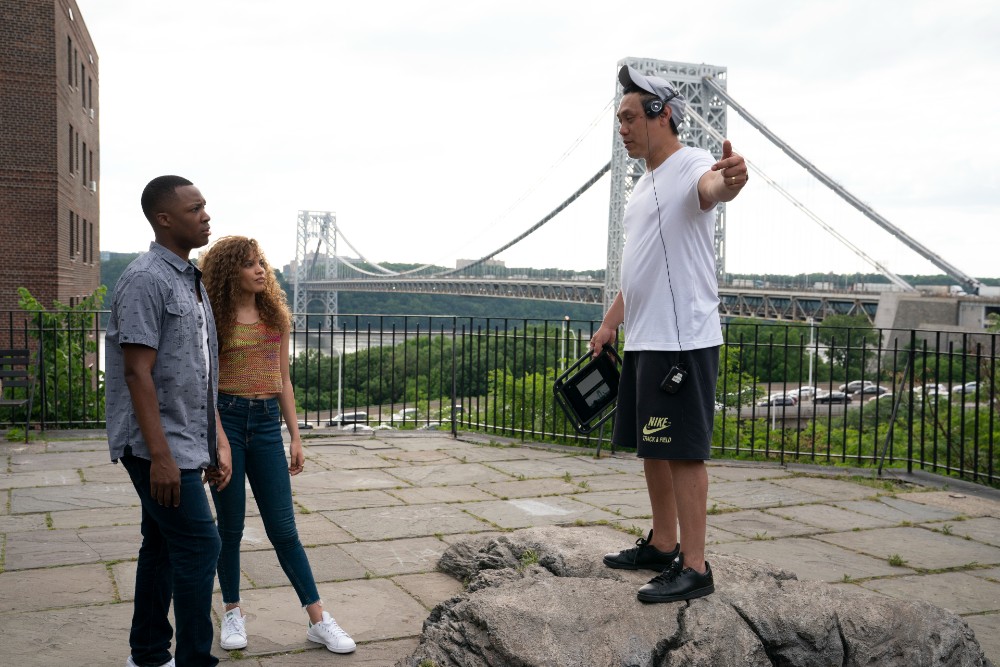
BTL: What was the time between finishing Crazy Rich Asians and Jon saying, “I got In the Heights, do you want to come do it with me?” Was it pretty organic?
Coates: Here’s the crazy thing. I actually was doing a show that films partly in New York when In the Heights was on Broadway its first month and didn’t even know about the show. Some of my crew were like, “Hey, this thing has opened up, and it seems like it’s right up your alley…” Anytime I’m in New York, I will try to get off the set as fast as possible and go grab a last-minute ticket to something, just to see as much as I can. I got a ticket and was just blown away. We were there for 10 days, I ended up getting tickets for and seeing the show three times in that 10-day period. I knew it was, it would be a movie someday. It was just so amazing, and I kind have been chasing it ever since.
But then different directors and different studios had it, and they had their people. It was just kind of, “Well, I guess it’s not meant for me to do this.” I had read the book for Crazy Rich Asians, and we were chasing that like crazy. I knew going into my meeting with Jon that he was already attached to do In the Heights, but I didn’t tell him I’ve been chasing that movie. We were about two weeks into filming in Kuala Lumpur on Crazy Rich Asians, and Jon looked over to me and goes, “Hey, what are you doing after this?” I said that I didn’t have anything booked yet. He goes, “Would you be interested in doing this musical called In the Heights?” And I went, “Oh, that sounds cool,” but totally played it cool and didn’t tell him that it was a dream of mine.
He didn’t know until much later. We did a Ken Jeung comedy special for Netflix, and we ran up to Vancouver and did an Apple TV series called Home Before Dark and then Jon went off to New York while I was still finishing that series. The last night he was still in Vancouver, I kind of came clean, and he was like, “You dork. I can’t believe you.” That’s kind of that Genesis. Jon had such amazing ideas for In the Heights. So many musicals have a similar idea that everything is a variation on a theme as you go through the show. His idea was to make each musical number its own standalone identity and to really add particular flavors to each of those and tell the story differently as we go along. As you can see from the response, it was a great tactic. For each of those particular ideas, we talked about kind of the little seed, and then that germinated over the next few months as we continued. I ran from Vancouver to New York the last weekend of January 2019, and Jon came into town, and we ran around, scouted, for three days, and had meetings. And then I went back to Vancouver to finish Home Before Dark, and when I finished that, at the end of March, ran back to New York and started prepping in earnest.
BTL: I assume that visiting Washington Heights was one of the first things you guys did. Were you able to figure out how much you could shoot there? I’m not up there that often ‘cause I live on the exact opposite end of Manhattan, so I don’t know how busy it is.
Coates: I’ve actually lived on the Upper East Side back before moving out to LA, and I had friends that lived in Washington Heights. I knew it, but to see it with new eyes, how you’re telling the story, and also, you’re trying to present an entire area of a city and introduce an audience to that. Basically, you have to figure out what are the flavors and the architectural details and the small life details of an entire neighborhood and bring them into the frame, what you’re going to actually be filming. As you know, New York has a density and lots of challenges to filming. That January scout was really incredibly important to identify our hero intersection, so that we could start working through all the processes with the neighborhood organizations and the city with fire and police, so that we could get people on board soon enough to be able to take over for about three weeks of filming, and be able to intermittently close streets, etc. That’s what January was about, and Lin and Quiara [Alegría-Hudes, co-writer of the musical] were really encouraging us to be east of Broadway, because that is the more historically Dominican, Cuban and Puerto Rican neighborhood. Certain intersections were too busy, and just would never be able to be closed, and as we started honing in, the intersection of 175th and Audubon had been redone a couple of years prior with wider sidewalks and some traffic mitigating larger corners, which we thought that would be to our advantage in the dance sequences. Also, when you can’t close the street, to have some wider sidewalks to be able to film on was going to be great. Alice Brooks, the cinematographer, was doing Home Before Dark with us, but she couldn’t go to this first scout. She asked, “If at all possible, find a bodega location that would be on a southwest corner.” And the 1/75 and Autobahn had an existing bodega that doesn’t look like our bodega in the movie, but it had a place for that, and the opposite corner had a car service, so we had two kinds of anchor points. Once we landed on that intersection, then we were starting with our location department to speak to all the vendors and all the apartment owners and landlords for a basically a four-block… a block each direction both sides, because we ended up doing facades and signage and dressing and painting. Basically, the weakest corner, the southwest corner, was a garden apartment below street grade, and we built the salon there. In the Heights, there are several different places where people have built out in front of apartments. They’ve built restaurants or businesses where it pushes out beyond the front of the apartment building. So using that as a kind of a template, an idea, then I pitched Jon our building the salon for that corner to kind of strengthen the corner.
Literally, there’s the feeling when you watch the movie that the entire movie shot right on that intersection, and in actuality, the majority of the movie was shot on stage. Once we built the salon there and built the front and dressed and changed what you could see of the bodega, then those facades were then transported later to a stage, the Marcy Armory in Brooklyn, which is kind of the largest space in New York, and then built the sidewalks and the streets and crosswalks and trees and cars, so that we could be inside those two environments and look back and forth and see them in relationship to each other.
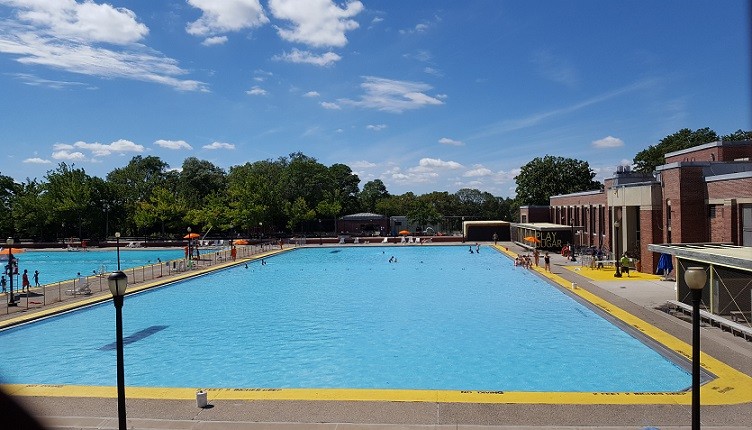
BTL: I was just looking at a map now, and I don’t think I ever realized that that part of Manhattan tapers off to the point where it’s only about eight blocks between the two rivers.
Coates: Actually, there is more square footage of park space in that section of Manhattan than anywhere else. Highbridge Park, which Jon had seen on his very first scout with Lin, then kind of predicated the idea of doing “96,000” in the Highbridge Park Pool. And there’s two different pools there. They’re old reservoirs for the northern part of Manhattan, and they eventually got modified into being the swimming pool. It’s the largest pools in all five boroughs. We met with the Park Service then, in January, on that first scout as well and started the conversation of what it would take to be able to take over. The parks, I tip my hat to them, they said, “Well, we serve as our communities, and we will not change our opening day for the community. And so, if we can figure it out before then great.”
Well, the pools needed to be rehabbed. We needed to take down a lot of fencing and railings and things that you use for public liability. We had to really be working with them closely. I gave them the color that I wanted the pools to be painted and what needed to happen, and it meant that they filled the pool from the aquifers earlier than they always did. And that meant that — because you have to allow the water to warm up a bit, because it’s really cold. So, in reality, we had a four-day window that shoots the pool sequence from when it was filled, and supposedly warmed up to a certain temperature, and then the moment that they were opening to the public. It was still incredibly cold for all the actors and singers and dancers. It was really cold… and then it rained all four days. They allowed us then to come in and dress banners and signage and after they had painted the pools and we took down other fencing elements. I’m so proud of what that does and how that grows the neighborhood, because most people in New York don’t even know that pool exists.
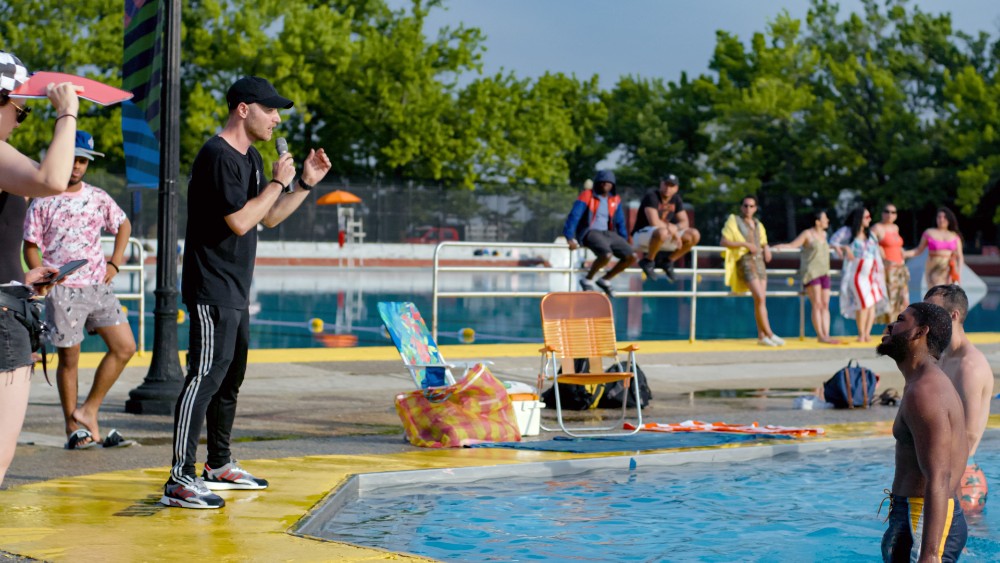
BTL: I’ve lived in New York City for 33 years now, and I’ve had zero interest in going to one of the public pools. I’ll be interested to see after this movie comes out, whether that pool gets crazy busy. It looks so gorgeous and fun, you want to go visit that swimming pool now!
Coates: And that beautiful, beautiful tower that’s there, and there’s the old Aquaphor Bridge (aka “The High Bridge”) that goes all the way to the Bronx that connects up right behind the pool that I’ve driven under for years, but I never really realized what all this was. So it’s exciting [because] no one’s ever filmed there, and I’m so grateful that the Park Service worked with us to be able to do that.
We were trying to create a tight sense of community, and in the Broadway show, where Claudia and Usnavy live, above the bodega, but in reality, that’s super challenging to do when you’re you’re on the corner of an apartment block. As we looked at this particular neighborhood, we realized that the townhomes that were on one side of the street where we built the salon actually provided an interesting cinematic moment for Usnavy to come out and walk past the salon and look toward the bridge and see the bodega in the very opening. It created a visual that was so strong that then we measured out how far we wanted him to walk in the song and approach the folks who lived in this townhouse, which happened to be ultra-modern. It had slick shiny black floors and gray walls and super high-end cabinetry in the kitchen. We convinced them to let us take it back, basically take over their home, and we built walls and redid the kitchen and painted everything, even did the old roller type wallpaper, where it’s not real wallpaper. It’s a paint roller that you paint on, because you see that a lot still up in the Heights, and their front glass window had double pane windows, sometimes they fail. We totally redid their windows and the front doors and everything, so we’d be able to shoot through and did the works to it. So much so they couldn’t believe… they were like, “This doesn’t look like anything we’ve ever seen.” And of course, we had to restore it back at the end.
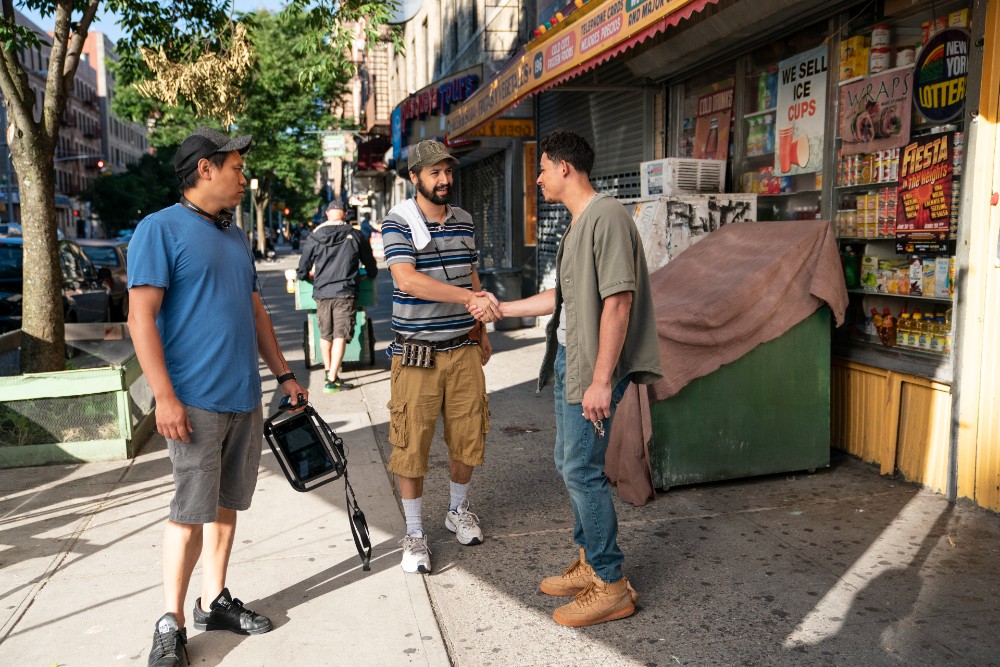
BTL: You did a great job making New York look really nice and appealing, even for someone who doesn’t go up in that area very much.
Coates: Well, it’s interesting. It’s so colorful, and literally, my first day in March, when I got back, I did two different things for research. My wonderful go-to Room 100 at the main Public Library in Bryant Park has the most incredible tear-sheet resources of photographs and parts from magazines, and they’re all cataloged. If you say, “Hey, I want to look up anything that might be Dominican,” you have file folders of these beautiful photo references of things and different eras — the 60s 70s 80s.
I went through anything I could find there for two days, related to any part of the movie, and found details of Dominican structures that then end up being the fretwork on the beach caja that later ends up in the bodega. After those two days of doing all that, then I walked every single street of the Heights, and about half the Bronx, I walked all of Inwood and about half of Harlem, just taking photos and copious notes about what made the bodegas and salons look different in the Heights than in these other neighborhoods, and what products were different. Even things like cardboard on the floor to soak up the rain in front of the front counter or what type of shelving and how that was handmade or anything like that that I could find. And then, in the production office, created a huge room of walls of “Here are the types of street murals and things that are happening now, and here’s what the bodegas looked like, and here’s the salons” and then started picking and choosing and saying, “Okay, these are the things that need to make it into the movie.” And then how do we connect up all those details?
Surprisingly, the Heights has turned into Chipotles and Chase Banks and Targets, like all of Manhattan has done, just not quite as fast as everywhere else. Also, there’s a certain LED lighting on all the windows to try to capture your attention, and salons and things have all gone now like just white paint. There’s a little bit of magical realism, as we bring back some elements of the Heights even from just about five or 10 years ago. We didn’t want it to play like a period movie, but we wanted some of those wonderful sunbleached signage, and the warmth, kind of the recent memory of the Heights, to bring that in. I mean, you still see a lot of these signs and awnings and things, but they’re just not all on one intersection. So it was like, “How do we bring this into the frame?” A lot of the supers had painted everything, it’s just a solid gray for the lower floors, but I found colors in other parts of the Heights, and I brought those colors in and convinced them to let us paint those.
BTL: My assistant editor will get very mad at me if I don’t ask about Hocus Pocus 2, because she’s a big fan of the original. Has that already started production? Have you already built all the sets for that?
Coates: Oh, no, no, it’s very early days. I mean, Monday was my first official day, so all I really can say is, I’m thrilled to be reteamed with Anne Fletcher, with whom I’ve done three other movies, including The Proposal, and Adam Shankman, whom I’ve worked with. He produced a movie called The Last Song with Miley Cyrus, so I’m super thrilled to be reteamed with them and with Disney, and that’s all I can say at the moment. It’ll be great.
BTL: Have you studied the original movie a lot to recreate the house exactly or close to it?
Coates: I can’t even tell you what I’ve done.
BTL: Anyway, it’s great talking to you, and I hope In the Heights gets some of the awards attention for your production design as Crazy Rich Asians did.
Coates: Thank you for that. I can’t say enough about the collaboration process with Jon. He’s one of the most collaborative directors and most inventive with whom I’ve ever worked, and makes everyone feel that their contribution is the most important. And you see it in the movie. He lifts people up and creates. I mean, he put a dream team behind the camera, and he put a dream team in front of the camera. He sees things that others often miss.
In the Heights is available to stream on HBO Max. It’s also available on many VOD platforms, as well as on Bluray and DVD.
As luck would have it, the Set Decorators Society of America‘s SETDECOR magazine just ran an interview with In the Heights Set Decorator Andrew Baseman SDSA, including some great photos of the bodegas discussed above.
All film stills courtesy Warner Bros. Pictures, all others courtesy the respective copyright holders.





